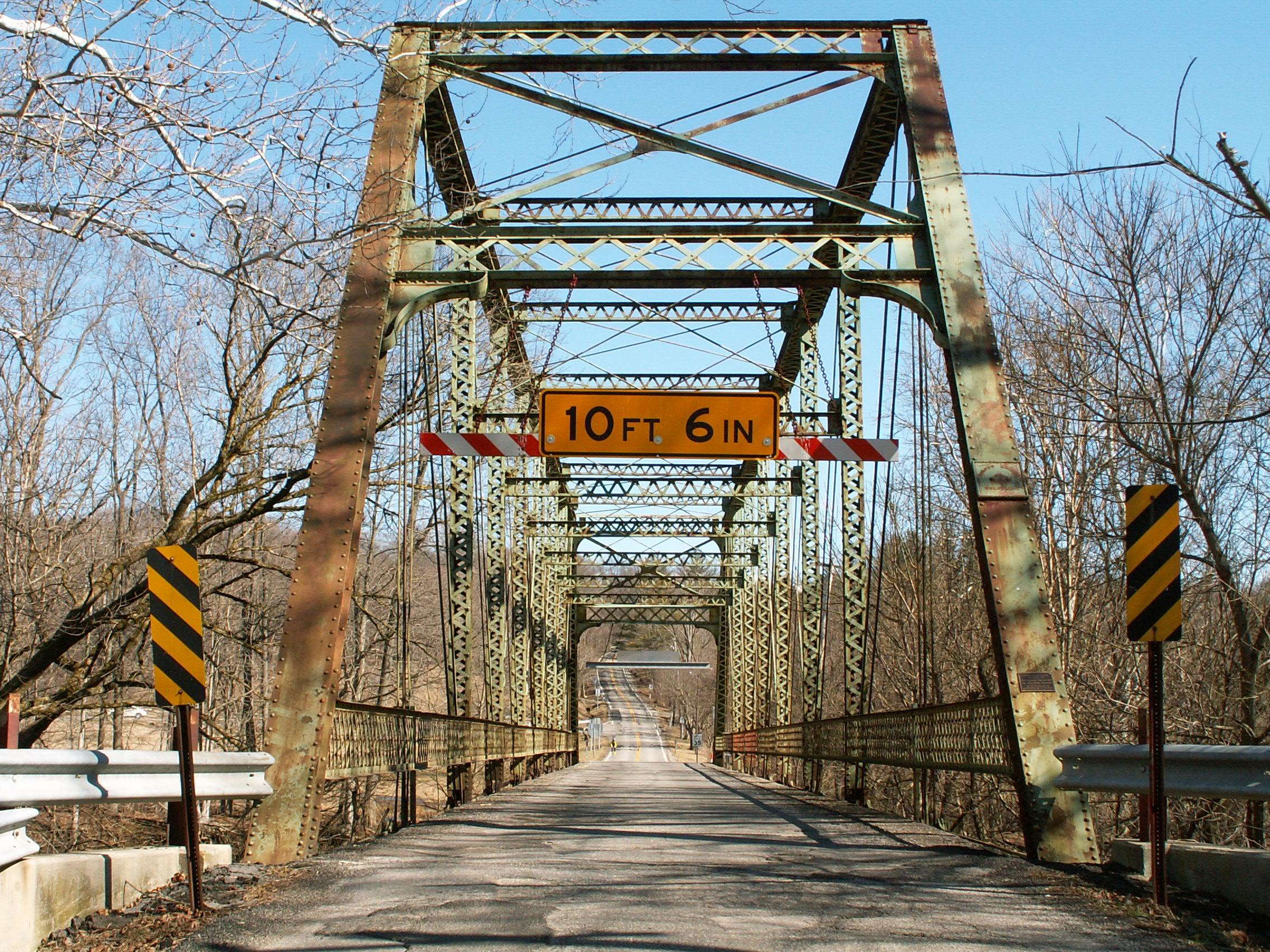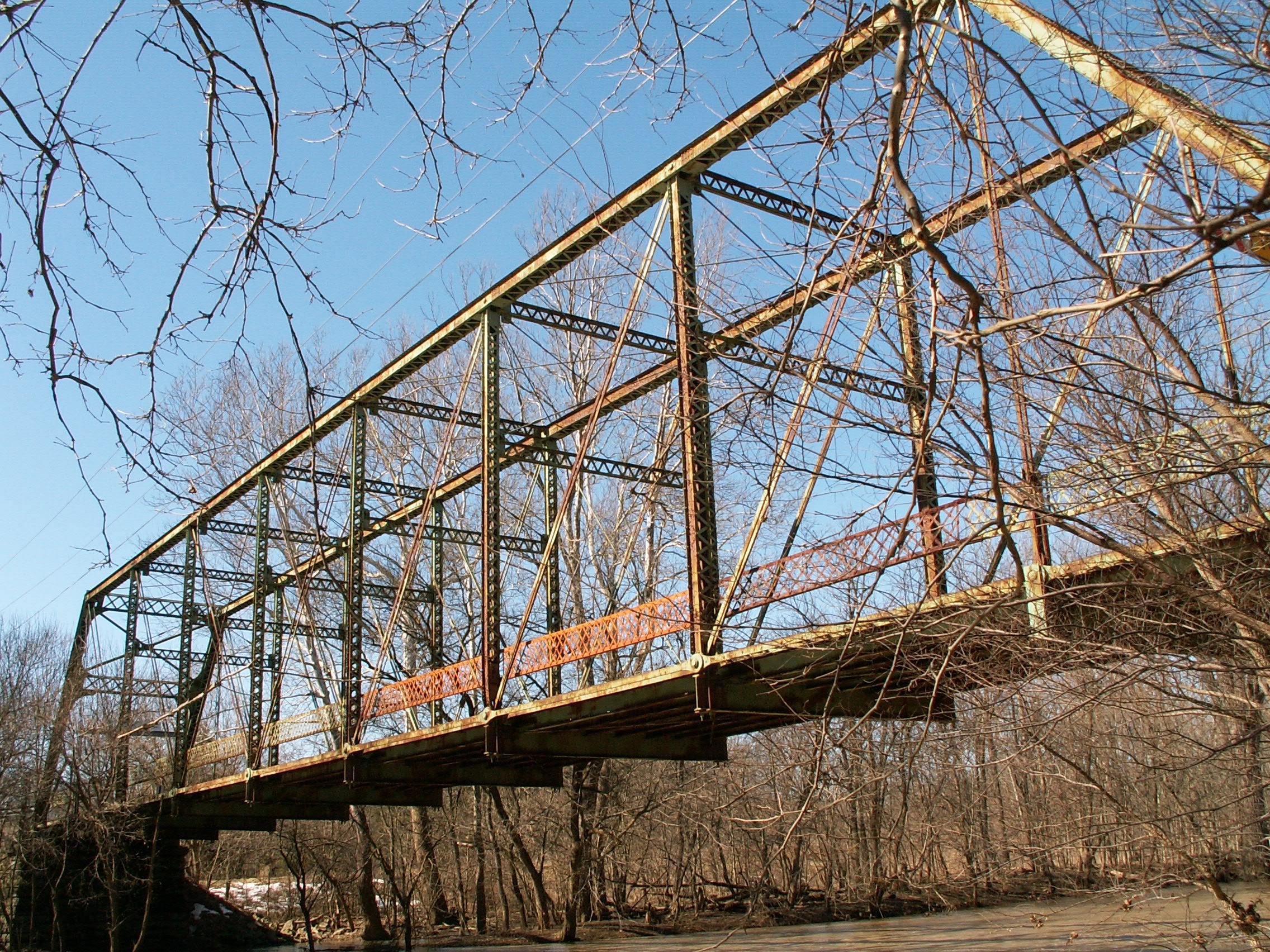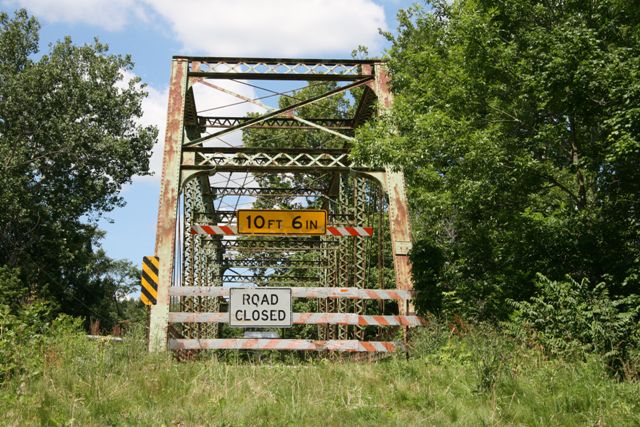We Recommend:
Bach Steel - Experts at historic truss bridge restoration.
BridgeHunter.com Phase 1 is released to the public! - Visit Now
Orange Road Bridge

Primary Photographer(s): Nathan Holth and Rick McOmber
Bridge Documented: March 2, 2007 and June 20, 2010
Rural: Delaware County, Ohio: United States
1898 By Builder/Contractor: Toledo Bridge Company of Toledo, Ohio (Former Smith Bridge Company of Toledo, Ohio)
1970
180.0 Feet (54.9 Meters)
182.0 Feet (55.5 Meters)
16 Feet (4.88 Meters)
1 Main Span(s)
2132184

View Information About HSR Ratings
Bridge Documentation
This bridge's future is at risk!
Bridge Status: This historic bridge has been bypassed, but its fate remains in question, and demolition is a possibility!View Archived National Bridge Inventory Report - Has Additional Details and Evaluation
Overview of Bridge
This breathtaking bridge was built in 1898 by the Toledo Bridge Company (which was originally the Smith Bridge Company). Abutments are original stone at the west end of the bridge, while the east end of the bridge has a concrete abutment. The bridge retains a remarkable amount of historic integrity, including original floor beams and lattice railings, as well as builder and commissioner plaques remaining on the bridge. The bridge is a nine panel structure. It features attractive v-lacing on the sway bracing, under the top chord / end post, as well as on the vertical members. Lattice is present on the portal bracing and on the railings.
The Orange Road Bridge is a very long example of a single-span pin-connected Pratt through truss. It is uncommon to find a traditional late 19th century pin-connected Pratt truss at this length. As a function of its length, it features taller, impressive trusses that feature a more complex network of sway bracing that more commonly shows up in Whipple truss which were often more preferred for spans of this length.
The first section of bottom chord (between the end post and the hip vertical) is not the standard eye bar but is instead an unusual built-up beam that has an unusual corrugated form of v-lacing (sometimes called ribbon lacing). Historic bridge expert David Simmons believes that this is due to the unique elevated position of the bridge, relative to the approaching road. He believes that the Toledo Bridge Company did this to add support to the bridge as the angle at which vehicles would enter the bridge would be different due to the elevated position. It should also be noted that railroad bridges sometimes display this detail as well.
Structural Condition
Unfortunately, the flooring system (floor beams and deck stringers) on this bridge are in poor condition. This is a typical trouble spot for a truss bridge, however, and is possible to easilly correct through a preservation project. The remainder of the truss superstructure is in good condition however, and would take to a rehabilitation project quite well. The stone abutment at the west end of the bridge has lost much of its mortar, and the stones have begun to separate. Again however, this could be corrected as part of a restoration project.
A Fate Uncertain!
This bridge was bypassed in 2009 by a new bridge on a different alignment. The bridge was left standing next to its replacement, but has remained at risk of demolition. The historic bridge has a lot of support from the community who do not want this beautiful historic bridge reduced to scrap metal, but for whatever reason the Delaware County Engineer does not want to leave the bridge standing where it is, and has threatened to demolish it numerous times. Therefore, for some time now, efforts have been underway to raise money and arrange to relocate and preserve the bridge elsewhere. As of May 2013, the plan was to move the bridge to cross Wildcat Run in Liberty Township Park, located at the southwest corner of Home and Liberty roads. As November 2013, efforts are apparently still underway to raise funds to relocate the bridge. If you are interested in helping save this bridge through a donation, donations can be made to the Liberty Township Foundation Fund's Liberty Bridges Fund.
Until funds are fully secured to relocate the bridge, this historic bridge should be considered to be at risk for demolition.
Ideas For A Restoration Project
It is imperative to retain the historic integrity of the bridge. In particular, leaving the original railings on the bridge is of great importance. If modern safety railings are needed, they should produce a minimal visual impact on the bridge and can be placed in front of the original railings without having to remove the original railings. It is also important that a restoration respect the original design of the bridge. If rivets have failed on the bridge, they should be replaced with rivets. There are contractors who have restored bridges and know how to rivet. If the floor beams need to be replaced, they should be replicated. The floor beams on Orange Road Bridge are American Standard Beams, and as such if replaced, they should not be replaced with wide flange beams. American Standard Beams are still manufactured, and are available for bridge restorations.
Information and Findings From Ohio's Historic Bridge InventorySetting/Context The bridge carries a 2 lane road over a stream in a rural setting with scattered 20th century residences. Physical Description The 1 span, 182'-long pin-connected Pratt thru truss bridge is traditionally composed of built-up compression members and eye bar or rod tension members. Due to the length, it has sub-lateral struts and bracing for extra stiffening. Integrity Relocated in 1913. Stringers and deck replaced in 1970. Summary of Significance The 1898 Pratt thru truss bridge is a fine and long-span example of this period type/design. There has been no significant change in the bridge's status since the prior inventory other than it will be closed and
bypassed by a new bridge. The bridge was NR listed in 2002. Justification The bridge is one of over 150 extant pin-connected truss bridges dating from 1874 for pony trusses and 1876 for thru trusses. Twenty six predate 1888 and represent the era of experimentation that evolved into standardized designs by about 1888. This example has moderate significance because the genre and the fabricator are so well represented in Ohio. Bridge Considered Historic By Survey: Yes |
This bridge is tagged with the following special condition(s): Unorganized Photos
![]()
Photo Galleries and Videos: Orange Road Bridge
Original / Full Size Gallery
Original / Full Size PhotosFor the best visual immersion and full detail, or for use as a desktop background, this gallery presents selected overview and detail photos for this bridge in the original digital camera resolution. This gallery offers photos in the highest available resolution and file size in a touch-friendly popup viewer.
Alternatively, Browse Without Using Viewer
![]()
Structure Overview
Mobile Optimized PhotosA collection of overview photos that show the bridge as a whole and general areas of the bridge. This gallery features data-friendly, fast-loading photos in a touch-friendly popup viewer.
Alternatively, Browse Without Using Viewer
![]()
Structure Details
Mobile Optimized PhotosA collection of detail photos that document the parts, construction, and condition of the bridge. This gallery features data-friendly, fast-loading photos in a touch-friendly popup viewer.
Alternatively, Browse Without Using Viewer
![]()
Additional Unorganized Photos
Original / Full Size PhotosA supplemental collection of photos that are from additional visit(s) to the bridge and have not been organized or captioned. This gallery offers photos in the highest available resolution and file size in a touch-friendly popup viewer.
Alternatively, Browse Without Using Viewer
![]()
Additional Unorganized Photos
Mobile Optimized PhotosA supplemental collection of photos that are from additional visit(s) to the bridge and have not been organized or captioned. This gallery features data-friendly, fast-loading photos in a touch-friendly popup viewer.
Alternatively, Browse Without Using Viewer
![]()
Maps and Links: Orange Road Bridge
Coordinates (Latitude, Longitude):
Search For Additional Bridge Listings:
Bridgehunter.com: View listed bridges within 0.5 miles (0.8 kilometers) of this bridge.
Bridgehunter.com: View listed bridges within 10 miles (16 kilometers) of this bridge.
Additional Maps:
Google Streetview (If Available)
GeoHack (Additional Links and Coordinates)
Apple Maps (Via DuckDuckGo Search)
Apple Maps (Apple devices only)
Android: Open Location In Your Map or GPS App
Flickr Gallery (Find Nearby Photos)
Wikimedia Commons (Find Nearby Photos)
Directions Via Sygic For Android
Directions Via Sygic For iOS and Android Dolphin Browser
USGS National Map (United States Only)
Historical USGS Topo Maps (United States Only)
Historic Aerials (United States Only)
CalTopo Maps (United States Only)





